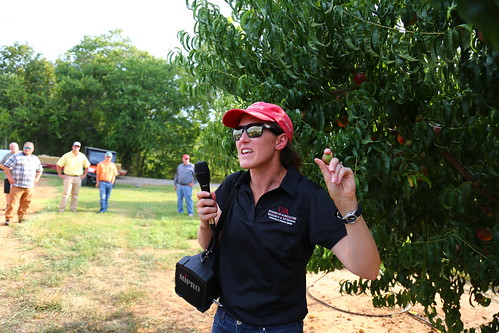Peach field day brings experts, growers together for sweet relief
By Ryan McGeeney
U of A System Division of Agriculture
July 18, 2018
Fast Facts:
- Field day focuses on growing techniques, integrated pest management and pathology
- Events often feature both Division of Ag experts and out-of-state speakers
- Ongoing Division of Ag field day schedule posted at http://bit.ly/YieldOfDreams2018
(666 words)
(Newsrooms: with art at https://flic.kr/s/aHsmj6ybWU)
(Download this story in MS Word format here.)
CLARKSVILLE, Ark. — A crowd of about 75 peach experts and growers — both commercial and hobbyist — gathered last week for an in-depth exploration of challenges facing growers and breeders throughout the state.
Staff and faculty with the University of Arkansas System Division of Agriculture’s Fruit Research Station hosted the event, which featured presentations from both Division of Agriculture fruit and produce experts, as well as experts from Clemson University and the University of Georgia.
Margaret Worthington, Assistant Professor of Horticulture for the Division of Agriculture, discussed varieties of peaches and nectarines developed in Arkansas. She said the purpose of the workshop — or field day, as such events are commonly known —was to give growers insight into various aspects of production statewide, as well as current research findings in pest management, pathology and varietal breeding.
“We have a strong tradition of cultivar development here at the University of Arkansas,” Worthington said. “We’ve always had a strong history of developing products that are useful for farmers.”
Although peach production in Arkansas declined significantly over the past few decades, from about 1,600 acres in 2003 to about 550 acres in 2015, a number of growers still incorporate the crop as part of a larger farming operation. The U.S. Department of Agriculture reported that as recently as 2015, the most recent year for which data are available, the USDA reported Arkansas produced about 1,100 tons of peaches, yielding a production value of almost $2 million.
Amanda McWhirt, extension horticulture crop specialist for the Division of Agriculture, walked attendees through the basics of peach production. She said that despite the relatively small number of acres dedicated to peaches in Arkansas, it was important to work with growers to continue to thrive under challenging conditions.
“The general state of peaches in Arkansas has been pretty rough,” McWhirt said. “Growers have had some significant losses. But I think there’s still a lot of potential for an industry to grow here.
“One of the things we struggle with is disease control,” she said. “We’re trying to help provide resources to our growers so that they can be successful in combatting that challenge.”
Two visiting speakers, Prof. Guido Schnabel, from Clemson University, and Prof. Phil Brennan, from the University of Georgia, spoke about brown rot management and major peach spot diseases, respectively. Both diseases can drastically reduce peach growers’ marketable yield, McWhirt said.
Peach growers in the state have had to content with at least two freezing events in the last two years — in March 2017 and in April 2018 — squeezing the typically tight margins of most farming operations even more tightly. But Mark Morgan, co-owner of Peach Pickin’ Paradise, a “U-pick” operation near Lamar, Arkansas, said that the business remained rewarding, with each new season offering the promise of renewal.
“This year is really rough for us,” Morgan said. “We’ve probably only got about a 10 percent crop. But last year was a great year. And that’s just kind of the peach business: it’s up and down. One thing about a short crop is, you can come up and learn a few things at a field day like this.”
Morgan served as both teacher and student at the workshop, conducting a presentation of the history of his family’s Lamar operation, and staying throughout the day to learn what he could from the experts in attendance, he said.
“Dr. Brennan and Dr. Schnabel, both of their talks were tailored to what we do in Arkansas at a commercial level,” he said. “So to learn a few things from them is really beneficial.
“The extension service is a huge asset to growers like us — we can pick up a phone and call our county agent, and know that we’re going to get a good answer that I can make decisions on,” Morgan said. “It’s not biased information. It’d be scary to think of trying to run an operation without it.”
To learn about fruit production in Arkansas, contact your local Cooperative Extension Service agent or visit www.uaex.uada.edu.
About the Division of Agriculture
The University of Arkansas System Division of Agriculture’s mission is to strengthen agriculture, communities, and families by connecting trusted research to the adoption of best practices. Through the Agricultural Experiment Station and the Cooperative Extension Service, the Division of Agriculture conducts research and extension work within the nation’s historic land grant education system.
The Division of Agriculture is one of 20 entities within the University of Arkansas System. It has offices in all 75 counties in Arkansas and faculty on five system campuses.
Pursuant to 7 CFR § 15.3, the University of Arkansas System Division of Agriculture offers all its Extension and Research programs and services (including employment) without regard to race, color, sex, national origin, religion, age, disability, marital or veteran status, genetic information, sexual preference, pregnancy or any other legally protected status, and is an equal opportunity institution.
# # #
Media Contact: Ryan McGeeney
Communication Services
U of A System Division of Agriculture
Cooperative Extension Service
(501) 671-2120
rmcgeeney@uada.edu
